Superintendent of Schools Dr. Jack Zamary says rising health insurance rates, salaries and other fixed costs drove his request for a 5.7 percent spending increase for Monroe’s public schools.
Zamary is asking for a $60.5 million budget for fiscal year 2020-21, $3,258,788 more than the current $57.2 million spending plan.
“Health insurance, growing enrollment and fewer retirements are driving Monroe’s Board of Education budget increase,” Zamary said during an interview in his office Monday.
On Monday morning, First Selectman Ken Kellogg expressed his hope the request will be reduced before it comes before town voters in the spring.
“Obviously, I’m a strong supporter of education,” he said. “However, I don’t believe that the level of increase will be acceptable to the taxpayers at referendum. I anticipate the Board of Education will do its due diligence.”
Board of Education members began their review of the budget in a workshop Monday night.
Board of Education Chairwoman Donna Lane asked Kellogg for a change in the town charter allowing the deadline for the school board to submit its budget to the first selectman and Board of Finance to be changed from Jan. 9 to Jan. 23 to allow more time for review.
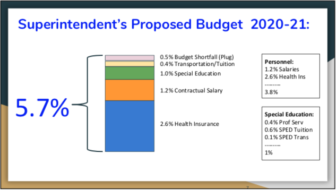 During a Town Council meeting Monday, Assistant Superintendent Joseph Kobza said a meeting was lost to a snow day so far, and the school board was going through a 250 page budget document line-by-line. He added, the board gets better financial predictions later in the process.
During a Town Council meeting Monday, Assistant Superintendent Joseph Kobza said a meeting was lost to a snow day so far, and the school board was going through a 250 page budget document line-by-line. He added, the board gets better financial predictions later in the process.
Town Council member Jason Maur asked if amending the charter for a permanent change on the new date was the intent of the Board of Education and Kobza said board members would also benefit from the change in future years.
The council voted unanimously to change the date in the charter.
Breakdown of the 5.7%
Zamary said 2.6 percent of the proposed spending increase for the entire budget is for health insurance, which would go from $9.25 million to $10.74 million.
When he was named superintendent in 2018-19, he said there was a $687,736 deficit in the Board of Education’s medical reserve. Due to years with high claims, the board’s self-funded insurance plan was not sustainable.
“The first committee I set up as superintendent was our Insurance Study Committee,” Zamary said. “We had the Board of Education, Board of Finance, first selectman, a Town Council representative, Central Office administration and the presidents of every bargaining group with the Board of Education. Everybody did an amazing job.”
The committee agreed to change insurance plans, switching to the state plan with the town.
“It gave us fixed health care costs, which is so much more predictable budgetarily,” Zamary said. “The risk and liability shifted from Monroe to the state of Connecticut.”
Though the fixed plan can be expensive for that stability, Zamary said the town is in much better shape than under the self-insured plan.
“If we stayed with Cigna, we would have had a 24-percent increase in our health insurance,” he said. “By going to the state plan, we avoided paying another $2.2 million this current fiscal year. It was a cost avoidance of 3.8 percent on the current fiscal year’s budget.”
“While the budget situation is bad for health insurance costs, it would have been far worse if we hadn’t made this change,” Zamary said, adding the higher budgeted amount for insurance would have compounded the problem in 2020-21.
Rising enrollment
Salaries in the 2020-21 budget will rise from $36.77 million to $37.47 million, accounting for 1.2 percent of Zamary’s 5.7 percent requested increase.
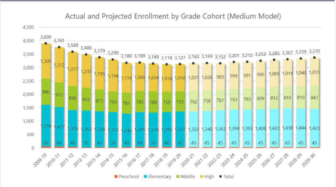 Though the district’s student population of 3,127 is less than the 3,899 students in 2009-10, Zamary points out how the district had students from Oxford, Prospect and Beacon Falls back then.
Though the district’s student population of 3,127 is less than the 3,899 students in 2009-10, Zamary points out how the district had students from Oxford, Prospect and Beacon Falls back then.
Enrollment rose by nine students last year. Zamary said most increases are at the elementary school level. Projections show a steady rise most years, until it is at 3,370 students in 2029-30, for a 7.8 percent increase.
“In the state of Connecticut, currently 155 of 186 municipalities are losing enrollment,” Zamary said. “Monroe is in that small minority that has growing enrollment.”
When enrollment was dropping, Zamary said there were big savings for the district following teacher retirements, because the positions could be eliminated. But now he says every position has to be filled, offsetting those savings.
There are also less retirements, because those eligible were hired in the early to mid-1980s, when hiring was down. Ten teachers retired in 2016-17 and 11 retired in 2017-18, but retirements dropped to six in 2018-19 and four this year.
Bang for the buck
Of the rest of the 5.7 percent increase, 1 percent is for special education, 0.4 percent is for transportation and 0.5 percent is for a $300,000 “budget shortfall (plug).”
Zamary said 62 cents of every dollar is for salaries and 18 cents of every dollar is for benefits, “so 80 cents of every dollar in the budget is for people.”
Transportation makes up 10 percent of the budget. Zamary said this means 90 cents of every dollar is for fixed costs.
“We can only cut things for schools: supplies, furniture and curriculum writing,” he said. “These are the things that get hit. All are important, but they’re not fixed costs.”
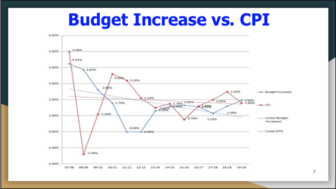 Zamary’s budget presentation includes statistics showing the town’s education spending has been below the rate of inflation for most of the past decade.
Zamary’s budget presentation includes statistics showing the town’s education spending has been below the rate of inflation for most of the past decade.
The superintendent also showed data on education budget increases over the last 10 years. There were 10 years with spending increases below two percent — in two of those years there was no increase at all.
The highest increases were 3.87 percent in 2008-09 and 2.6 in 2009-10.
Zamary said the district has had a total of $2.4 million in savings from energy efficiency over the past five years with participation in the Honeywell program, which resulted in improvements such as switching lighting to LEDs and making boiler upgrades.
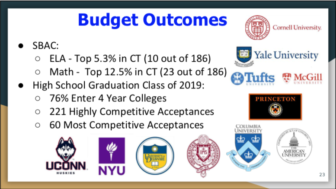 “We’ve made great efforts to be frugal, while delivering high quality programing,” he said.
“We’ve made great efforts to be frugal, while delivering high quality programing,” he said.
Zamary said students had historical highs on the SBAC test in English and math. Of the 2019 graduating class, 76 percent of graduates entered four year colleges in schools like Yale, NYU, Columbia University, Tufts and the University of Connecticut.
“People are getting some of the highest academic outcomes in the state for their money,” he said.
An open process
Zamary said the Board of Education made six pages of budget questions to go over Monday night, which will be posted on the school district’s website.
The superintendent said members of the public can go to Departments, Business Office, Budget Information and Budget 2020-21 to access budget documents and questions and answers throughout the process.
To ask a budget question, send an email to [email protected] and it will go to Zamary, Kobza and Interim Director of Finance and Operations Frank Connolly.
Zamary said budget changes leading up to his proposal and Education Cost grants for special education, back up documents for financials and Brown & Brown’s presentation to the school board for insurance will now be included on the Munis software.
The superintendent said this is all in the effort of transparency for the community.

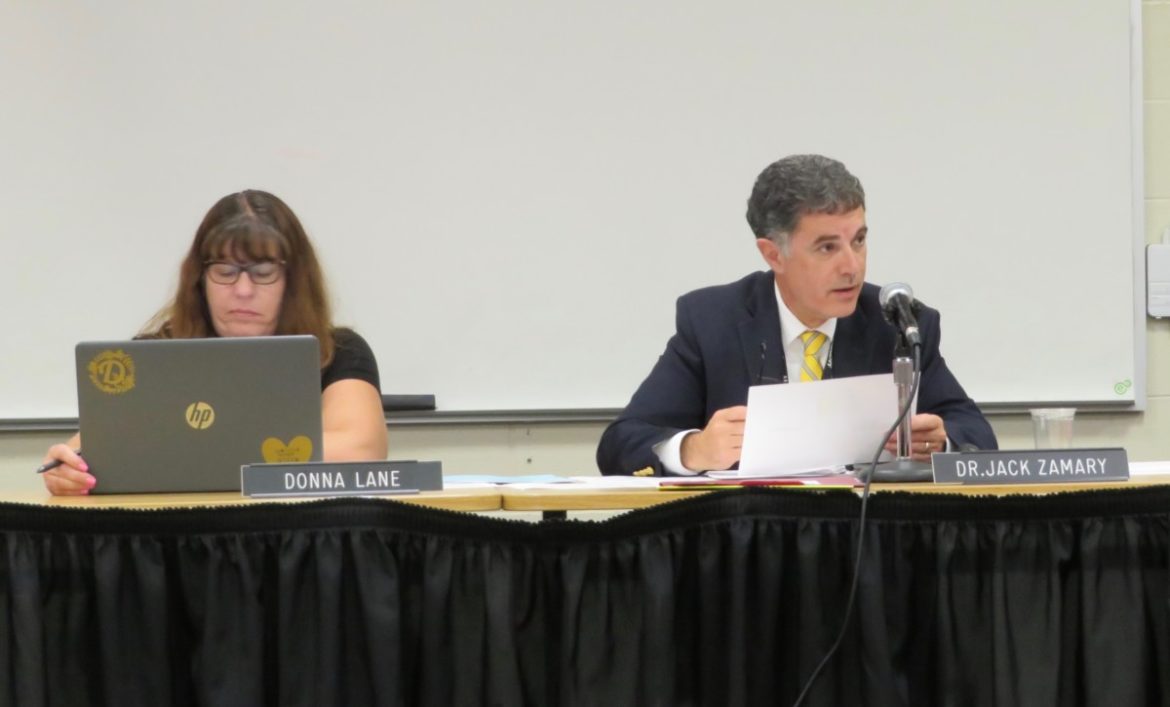



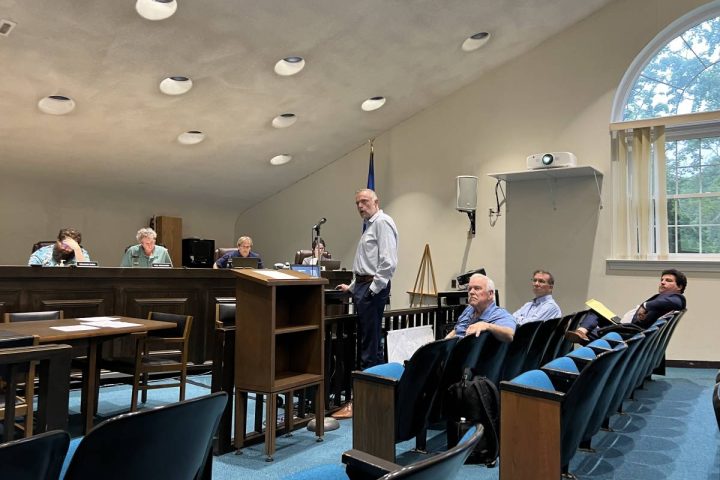


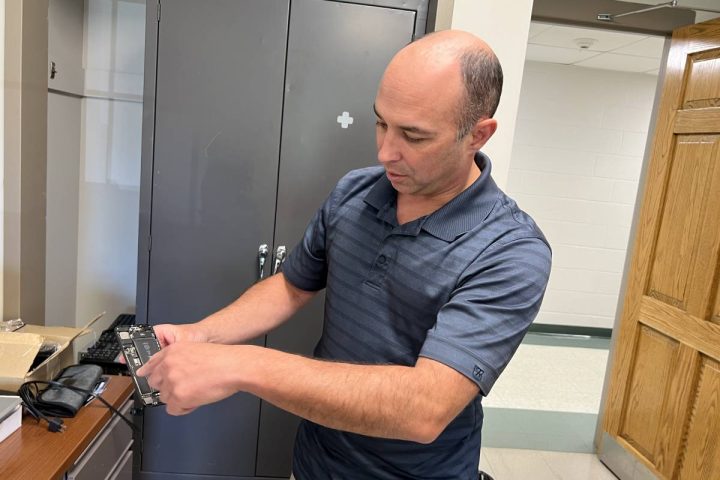
I did not study the board of education budget, so I am not remarking on the validity of the proposed expenses. I am remarking, however, on the use of statistics concerning historical budget increases. I think it is inaccurate to portray historical budgets with low year-to-year percentage increases as a reason for why a current proposed budget with a large percentage increase may be justified (as in a low average increase over a period of time). In the first place, I don’t think historical rates of increase are relevant to whether proposed expenses for an upcoming fiscal year are appropriate. Second, if statistics are to be used, I believe they should be presented in a fair and accurate manner.
Monroe’s board of education budgeting over the past decade has had the luxury of declining enrollment. In the absence if significantly declining enrollment, it is not so easy to have small percentage increases. With a declining enrollment, a small increase in total expenditures is actually a larger increase on a per-pupil basis. If historical percentage increases are to be used, adjusting them to a per-pupil percentage increase might be another way to portray the rate of increase as compared to inflation.
The state department of education publishes the “net current expenditure per pupil” (the “NCEP”) for all school districts on its website. The NCEP is the per pupil expenditure for all expenses, excluding or minus reimbursable transportation, tuition revenue, and school construction and renovation capital costs and debt service. The most recent year for which the data is available on the website is the 2017-18 fiscal year (the fiscal year beginning July 1, 2017).
The NCEP for Monroe was, per the state DOE website, for the fiscal years beginning: 7/1/07 = $10,920; 7/1/08 = $11,860; 7/1/09 = $12,813; 7/1/10 = $13,576; 7/1/11 = $14,025; 7/1/12 = $14,549; 7/1/13 = $15,066; 7/1/14 = $15,629; 7/1/15 = $16,371; 7/1/16 = $16,774; and 7/1/17 = $17,789.
The percentage increase in net current expenditures, on a per pupil basis, over the prior fiscal yer, was therefore, for the fiscal years beginning: 7/1/08 = 8.61%; 7/1/09 = 8.04%; 7/1/10 = 5.95%; 7/1/11 = 3.31%; 7/1/13 = 3.55%; 7/1/14 = 3.74%; 7/1/15 = 4.75%; 7/1/16 = 2.46%; and 7/1/17 = 6.05%.
It should also be pointed out that there are a number of costs that do not change based on the number of students. For example, the school system will have one superintendent and one principal per building no matter how many students there are. However, if the largest expense item is teacher compensation and benefits, that should change as a function of enrollment.
Ok without a deep dive into the budget -which in my opinion should be zero dollar based ( in other words start from scratch on what you need)
We all know costs go up and Health insurance is ridiculous but to simplify this discussion
$3,258,788 dollar increase over last year means $163 per person assuming the town still has 20,000 people.
Let’s get serious -this is unacceptable
Please school board -get to work